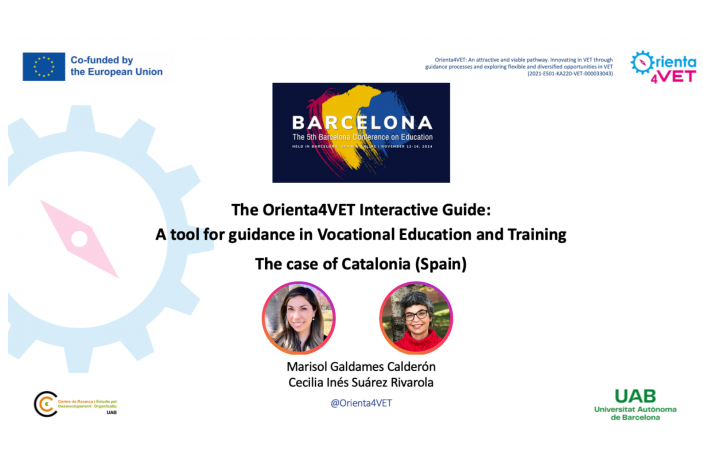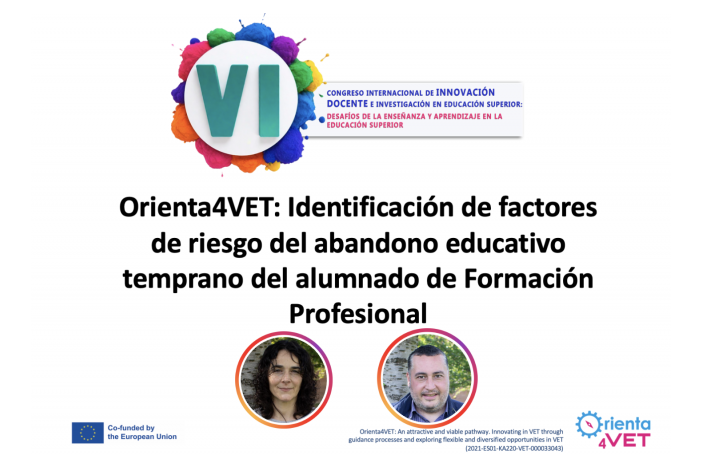Project description Objectives Workplan Participants Expected outputs
Orienta4VET project seeks to work on and towards VET access and contributing inand for staying and completing upper secondary education, especially focusingon orientation mechanisms and tutorial actions.
Orienta4VET project will seek to work on and towards VET access and contribute in and for staying and completing these programs. Its work lines linked to three of the specific priorities of the KA220-VET program: 1) increasing visibility and attractiveness of VET, 2) increasing the flexibility of opportunities in VET and 3) contributing to innovation in VET
This project falls in the priority “Inclusion and diversity in all fields of education, training, youth and sport” and will seek to contribute to the promotion of social inclusion, improving the outreach to young people with fewer opportunities addressing the barriers faced by these groups in accessing and in the field of vocational education and training (both initialand continuing)
The main target groups are teachers/trainers and guidance teams who are involved in working with and supporting young people in initial/basic vocational education and training (VET) programmes (level 1) and intermediate VET programmes (level 2).
The project will produce tangible results divided in four areas of intervention, contributing to provide results to build the VET scenarios 2035 (Cedefop, 2020): (1) pluralistic VET that implies a redefinition of VET’s overall position in the education and training system; (2) individually tailored teaching, learning and guidance solutions; (3) progression and pathways of vocationally oriented learning throughout life and portability of vocational learning; (4) flexible pathways.
-
Project description
-
Objectives
-
Workplan
-
Participants
-
Expected outputs

Background
VET has the potential to be an effective way to enter the workforce, particulary for young people
OECD,2018
Vocational programs are considered more effective in developing skills that allow earlier access to the labour market
OECD,2020
Upper secondary education is essential for persuing futher levels of education or continuing in education and/or training
Olmos & Díaz, 2020
There is a lack of an adequate guidance process and orientation mechanisms in VET
CEDEFOP, 2020
VET programmes are an alternative pathway for guiding young people who have had difficulties in previous educational stages
Work lines of project
(a) Increasing visibility and attractiveness of VET
(b) Increasing the flexibility of opportunities in VET
(c) Contributing to innovation in VET
Four operationals Objectives
To make VET visible in our contexts identifying and analysing its main problems and its social impact, taking as reference indicators such as personal, educational / training, business and / or productive development of the territory, socio-labour or socialprofessional integration (especially of the youngest), early school leaving, NEET, etc.
To explore potentiality and viability of alternative pathways that facilitate the diversification and flexibility of access opportunities in VET (or the educational / training re-entry through vocational pathways).
To implement adequate orientation and tutorial action strategies in VET itineraries and analysing their impact, working on guidance strategies and tutorial action for its implementation and evaluation in VET.
To create capacity building of VET educational agents on guidance processes, orientation, and tutorial action strategies as integrated elements of their teaching and learning processes
The project is based on five pillars of intervention:
People: Teachers/trainers, guidance teams and other educational agents will be considered in the intervention plan included in the project as the professionals who work on and with young people, leading them in their vocational itineraries
Organization: The context of intervention is critical in any change and innovative process. Without an organisational view, any change is impossible to la
Interaction: It is well known that in education and more specifically in the educational context where guidance plays a key role.
Resources: The project will contribute to creating valid and adapted resources for teachers/trainers, leaders, and other stakeholders in VET.
VET Gaps: The project will address the main “VET gaps” addressed to promoting access and participation in VET, working on increasing the attractiveness of VET at different levels and contributing to innovation in VET.
Targets
Young people, as the teaching and learning groups of involved VET educational agents and centres. This target group will be the "indirect" beneficiary of Orienta4VET proposal since they will the target groups of the VET educational agents implementations.
Teachers/trainers from VET education programmes. They represent the relevant end-users, and they will be targeted by means of the work of the project partners and the general dissemination strategies
Guidance teams and other educational agents will be considered in the intervention plan included in the project as the professionals who work on and with young people, leading them in their vocational itineraries
VET apprenticeships centres and local external educational agents, which work with VET educational centres on reinforcing their links at local level.
External organisations, particularly Educational Administrations, which work on reinforcing VET links with local, national, European and international organisations and communities.
These areas of intervention are corresponding to three main project results
PR1. Orienta4VET shared and interactive guidance plan (interactive guide). It will be a shared, active, and interactive guide for the implementation of VET orientation and tutorial strategies / actions.
PR2. Orienta4VET interactive map. It looks for being an accessible tool and resource useful for counsellors, teachers / trainers, young people, researchers, educational centres, external educational agents, educational Administration, etc. in the VET field.
PR3. Orienta4VET MOOC. It will develop an accessible training resource that contributes to VET educational agents’ capacity building on implementing guidance processes and orientation and tutorial action strategies as integrated elements of their teaching and learning processes.

- Description
- Objectives
- Target
- Workplan
- Expected outputs
The upper secondary education is essential for both pursuing further levels of education, or continue in education and/or training, and for a successful labour market integration. The development and strengthening of this educational level — particularly in vocational — becomes a priority line of action to address equity in education and work towards more inclusive education and societies, with lower unemployment rates (especially youth unemployment) and lower rate of population that neither continue studying nor working.
Vocational education and training (VET) is introduced as one of the most attractive options to gain access to the job market (especially for youths between 15 and 19 years old), as well as for to return to training itineraries (especially in adulthood) that allow academic accreditation of competencies in favour of better employability and go forward higher degree training programs.
We cannot underestimate the potential of VET as a way to successful labour market integration and social inclusion, as vocational programs are considered more effective in developing skills that allow earlier access to the labour market. Despite having improved its social perception, VET continues to be the non-priority option. Nevertheless, it is also worth highlighting other reasons: the lack of an adequate guidance process and adequate orientation mechanisms and tutorial actions, processes, or strategies that in some cases provoke the students’ disengagement and its consequent early leaving from education and training without obtaining a minimum academic and vocational qualification to gain access to the labour market.
VET has an undervalued and unrealistic social image, so VET needs evidence to demonstrate its effectiveness and its contribution to personal development and social and economic balance — VET is a tool of both labour integration and social inclusion. For that reason, working on making access to VET in upper secondary education more attractive, as well as strengthening and guaranteeing their permanence and completion, is presented as one of the educational challenges of today's society.
Orienta4VET project will seek to work on and towards VET access and contributing in and for staying and completing upper secondary education, specially focusing on orientation mechanisms and tutorial actions.
Orienta4VET seeks to contribute to the promotion of social inclusion, improving the outreach to young people with fewer opportunities addressing the barriers faced by these groups in accessing and in the field of vocational education and training (both initial and continuing).
1. Making VET visible in each context identifying and analysing its main problems and its social impact.
2. Exploring potentiality and viability of alternative pathways that facilitate the diversification and flexibility of access opportunities in VET (or the educational/ training re-entry through vocational pathways).
3. Implementing adequate orientation and tutorial action strategies in VET itineraries and analysing their impact.
4. Capacity building of VET educational agents on guidance processes and orientation and tutorial action strategies as integrated elements of their teaching and learning processes.
The main target group are teachers/trainers and guidance teams who are involved in working with and supporting young people in initial/basic vocational education and training (VET) programmes (level 1) and intermediate VET programmes (level 2).
1. Young people
2. Teachers/trainers
3. Guidance teams
4. VET educational institutions
The project is based on five pillars of intervention:
1. PEOPLE. Teachers / trainers, guidance teams and other educational agents will be considered in the intervention plan included in the project as the professionals who work on and with young people, leading them in their vocational itineraries. On the other hand, young people will be also considered as the centre of any intervention addressed to their global development, specifically their professional skills, that represents the main outcome and priority of any intervention plan.
2. ORGANISATION. The context of intervention is critical in any change and innovative process. Without an organisational view, any change is impossible to last.
3. INTERACTION. It is well known that in education and more specifically in educational context where guidance plays a key role, the interaction between involved educational agents is crucial.
4. RESOURCES. Tools and quality resources are key for any process of innovation and change. The project will contribute to creating valid and adapted resources for teachers / trainers, leaders, and other stakeholders in VET.
5. VET GAPS. The project will address the main “VET gaps” addressed to promoting access and participation in VET, working on increasing attractiveness of VET at different levels and contributing to innovation in VET.
This proposal is thought to be developed and implemented with the involvement of a minimum of 8 educational centres, in which Secondary Education is taught in its first (compulsory level) and second (upper level in vocational option) stage, per territory. In each one educational centre, there it is necessary to involve one driving-force team (working group) by educational centre integrated by 3 or 4 educational stakeholders that will actively participate in the design, revision, and validation of the projects results.
The project will produce tangible results divided in four areas of intervention, contributing to provide results to build the VET scenarios 2035 (Cedefop, 2020): (1) pluralistic VET that implies a redefinition of VET’s overall position in the education and training system; (2) individually tailored teaching, learning and guidance solutions; (3) progression and pathways of vocationally oriented learning throughout life and portability of vocational learning; (4) flexible pathways.
These areas of intervention are corresponding to three main project results (PR):
- Interactive guide: Orienta4VET shared and interactive guidance plan. Will be a shared, active, and interactive guide for the implementation of VET orientation and tutorial strategies / actions, which are understood as innovative teaching and learning approaches.
- Orienta4VET interactive map. An accessible tool and resource useful for counsellors, teachers / trainers, young people, researchers, educational centres, external educational agents, educational Administration, etc. in the VET field. This interactive map suits the reality of the territories involved on the project, being a response to specific demands and needs of the involved agents.
- Orienta4VET MOOC. Accessible training resource that contributes to VET educational agents’ capacity building on implementing guidance processes and orientation and tutorial action strategies as integrated elements of their teaching and learning processes. This MOOC resource will bring the interactive guide and the interactive map together as part of the training process.
News
UAB Professors Present the Orienta4VET Interactive Guide at the 5th Barcelona Conference on Education
Professors Marisol Galdames Calderón and Cecilia Suárez Rivarola from the Universitat Autònoma de Barcelona, Spain, are participating in the 5th Barcelona Conference on Education, held from ...
Professors Patricia Olmos Rueda and José Luis Muñoz Moreno Present Findings on Early School Leaving in VET at CIDICO 2024
Professor Patricia Olmos Rueda and Professor José Luis Muñoz Moreno have participated in the VI International Congress on Teaching Innovation and Research in Higher Education (CIDICO), presenting ...







